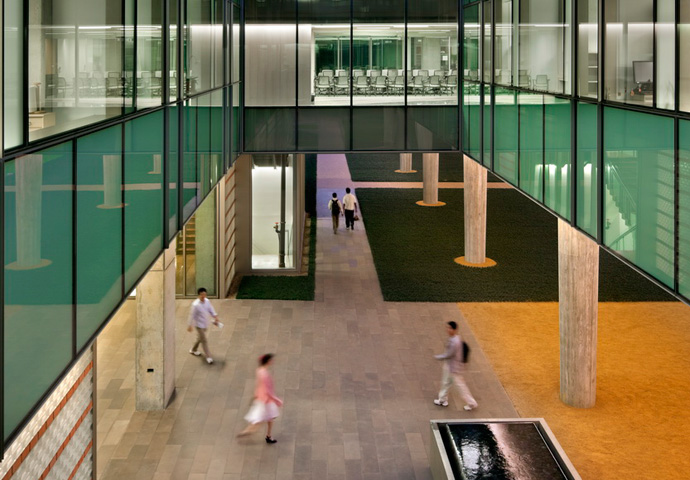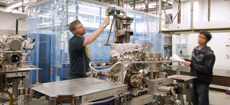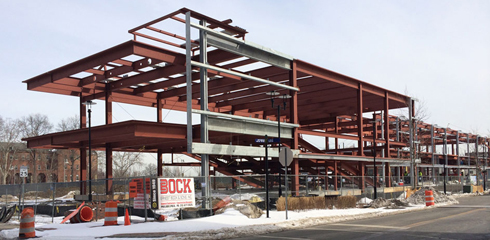Learning from Levine

Levine Hall's curtainwall glazing, visible from 34th Street south of Walnut Street, reflects adjacent buildings and seasonal variations—a nod to the University's historic context and changing environment.
© Barry Halkin
As we celebrate our 30th year in practice, we revisit some of our past works to see how they have matured and uncover what we can learn from them today.
By Fátima Olivieri
Completed in 2003 as part of the School of Engineering and Applied Sciences at the University of Pennsylvania, the Melvin J. and Claire Levine Hall is a 48,000 square-foot addition that adjoins two historic structures, the Graduate Research Wing of the Moore School and the Towne Building. This new structure was built as a home for the Department of Computer and Information Science, providing much-needed faculty offices, labs, classrooms, and student amenities such as the Wu and Chen Auditorium, Weiss Tech House, and a café.
With Levine Hall, the university wanted to amplify the work of the School of Engineering and demonstrate its pioneering spirit through architecture. KieranTimberlake proposed a narrow, 6-story, bridge-like addition that would connect the existing buildings and minimize the footprint at street level. Expansive glass curtainwalls were used as the primary facades to make the activities inside the building visible to all and to maximize light and view on a dense urban site.
A site plan shows the development of the block on the University of Pennsylvania campus.

The building was designed to bridge old and new, with the curtainwall facades of Levine Hall responding to the scale and proportion of nearby brick facades.
© Fátima Olivieri
A present-day view of Levine Hall from Chancellor Walk makes clear that the building met more than its programmatic requirements; it also set the tone for further development of the precinct. In line with Penn's tradition of internal pedestrian walks, Chancellor Street, once a city street and later a service corridor, has transformed into a pedestrian path terminating at Levine Hall's glass facade, enriching the passage between 34th and 33rd streets with a series of interior and exterior public rooms. The walk is now a hub of activity, with students passing to and from class, gathering on benches, and studying on sunny days. Students from different departments use the lobby of Levine as a cut-through, and meetings, bake sales, and study groups take place there throughout the day.
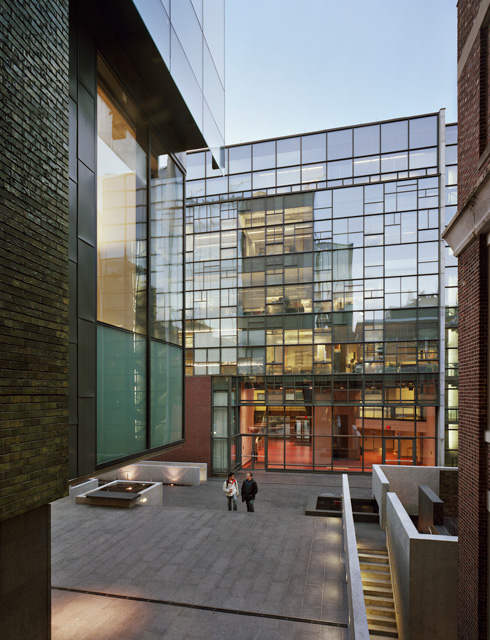
A view of the building from Skirkanich Hall, which completed the courtyard established by Levine Hall
© Michael Moran
Levine Hall was part of a master plan for the entire block and set the precedent for future construction. The building's slim footprint and siting along the western edge of the site created the opportunity for a larger open space to the east—the future Quain Courtyard. In 2006, Skirkanich Hall, designed by Tod Williams and Billie Tsien, replaced the former Pender Labs on 33rd Street, completing the courtyard established by Levine.
Today, Levine Hall exemplifies how contemporary buildings can coexist within a historic urban context. Alternating brick panels on the exterior combine with a glazed curtainwall facade to seam together neighboring materials. The actively ventilated curtainwall system (the first of its kind in North America) provides energy efficiency with maximum transparency. The scale and proportion of the glazing pattern was developed from proportional studies using the Golden Section. Reflections on the glass activate the facade during the day, while at night, the building glows.
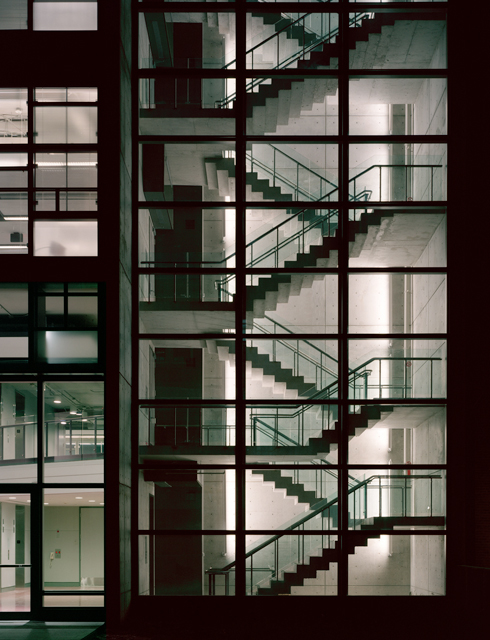
New circulation patterns established by Levine Hall lend a sense of order and legibility to the existing complex of buildings.
© Barry Halkin
The building is a hub of activity; along with a 150-person auditorium and café, the double-height entry lobby is a primary gathering space for the engineering community, with upper floors fostering collaboration between students and faculty. Faculty offices are located adjacent to open study spaces and lounge areas, where chalkboard walls are used for active study sessions.
The primary circulation serves as connecting tissue, threading together two buildings and various floor levels. The monumental steel and terrazzo stair anchors the lobby and provides a second entry to the auditorium through the use of a mezzanine. A concrete and glass stair along the east facade connects all six stories, rising over adjacent buildings and culminating in a view of the Philadelphia skyline beyond.
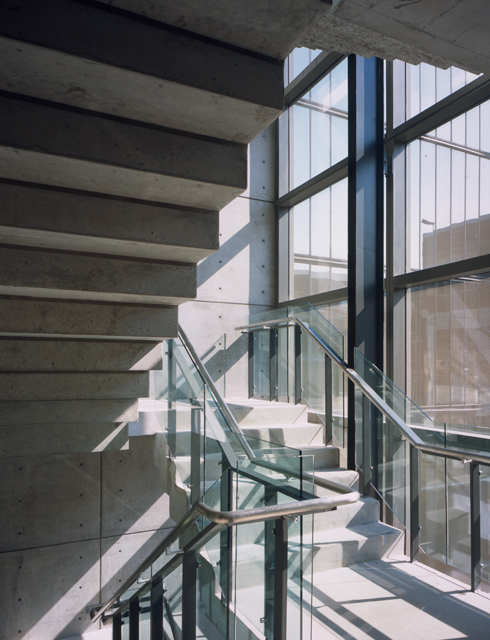
The east stair tower allows views over the Quain Courtyard and beyond adjacent buildings to the skyline of Center City Philadelphia. The frequently used stair also serves as a hub for students and faculty, a marker of activity within Levine Hall.
© Barry Halkin
Ideas explored in Levine Hall informed several subsequent projects at KieranTimberlake. Themes such as designing within a historical context, integrating the building with landscape, and the research and implementation of innovative technologies continue to permeate current work.
The curtainwall research begun at Levine Hall would later inform the multi-layer façade system of the Yale Sculpture Building, completed in 2011. Similar to Levine Hall's facade, the triple-glazed curtainwall with insulating translucent spandrel panels offers exceptional energy performance while embedding itself within a historical context. The exterior sun-shading system helps mitigate heat gain, its shape taking cues from Yale's gothic structures and tracery beyond.
The 2011 renovation of Morse and Ezra Stiles Colleges, also at Yale, takes lessons from the infill strategies and historical context of Levine Hall. Whereas Levine Hall inserts itself between buildings as a vertical bridge, at Morse and Stiles, the addition takes advantage of the topography, creating a series of exterior sunken rooms that bring light down into the lower-level public spaces of the project.
Similar to Levine Hall, the Edgar N. Putman Pavilion at the James A. Michener Art Museum creates a series of interior and exterior rooms, using the façade to reflect the context beyond. Completed in 2012, the structural panel glass pavilion sits within the museum's sculpture garden, creating two terraces and emphasizing the remaining fieldstone walls of the Bucks County Prison that once stood on the site.
Eleven years after its completion—having won an AIA Philadelphia Honor Award in 2003 and an Architect R+D Award in 2007—Levine Hall now sits amid the historic urban campus as a timeless example of the firm's core concepts: the integration of art, science, analysis, and intuition with the built environment. These are issues that resonate within today's architectural discourse, elements that we can see and learn from in looking at Levine Hall.




